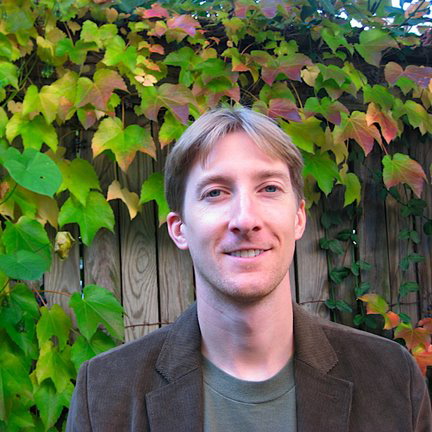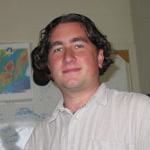Featured Stories, MIT, MIT EAPS, MIT News, WHOI, WHOI News | October 29, 2012
Coral Reefs and Sinking Islands: Revisiting Darwin’s Other Theory
by Genevieve Wanucha
The coral reefs encircling many volcanic ocean islands of the South Pacific appear in one of three forms. Tahiti’s coral, for example, forms a ‘fringing’ reef, a shelf growing close to the island’s shore. The ‘barrier’ reefs of Moorea are separated from the main island by a calm lagoon. Finally, an ‘atoll,’ such as Manuae, appears as a ring of coral enclosing a lagoon with no island at its center. During the voyage of the Beagle in the 1830s, the Pacific reefs impressed English naturalist Charles Darwin, inspiring some of his earliest evolutionary ideas. To him, the different reef forms reflect different stages in a dramatic process occurring as an island sinks.
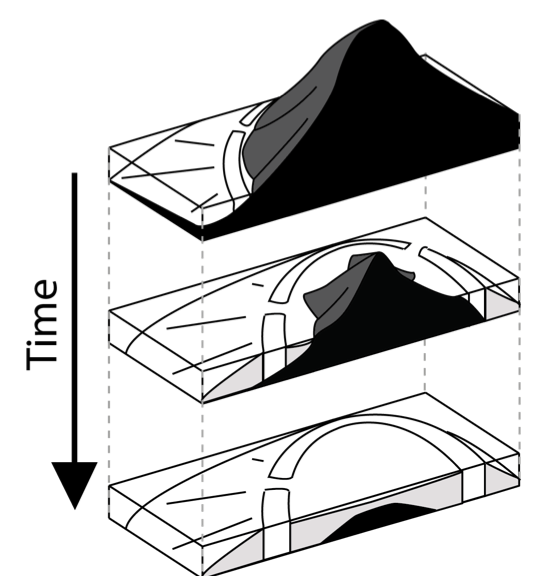
Strange as it seems to us continent dwellers, it’s true. The world’s volcanic ocean islands are sinking. As the young volcanic rock cools and is carried away from the volcanic “hot spot” by the movement of tectonic plates, the island sinks down as rapidly as a few millimeters per year. At the same time, Darwin proposed, the surfaces of the resident coral reefs grow upwards; the living coral organisms up top and their symbiotic algae get enough sunlight to keep pace with the vertical motion of the island. As the coral grows up and the island sinks down, a fringing reef progresses to a barrier reef, and eventually, leaves a signature atoll.
However, Darwin’s theory can’t explain the trajectories of other volcanic ocean island systems, as a certain group of researchers recently found. It all started when WHOI coastal geomorphologist Andrew Ashton and MIT-WHOI graduate student Michael Toomey were studying the effect of hurricanes in Tahiti’s lagoons but became “distracted by the corals” in the process. Soon, they convinced MIT’s Taylor Perron, who has an interest in ocean island landscapes, to join them in studying coral reef formation.
When they began to look beyond the Society Islands to the Hawaiian Islands system, they discovered a different kind of progression. For example, they found fringing reef where they expected to find no reef development and drowned barrier reefs where they expected living barrier reefs. “Those islands are just not sinking into atolls like the Society Islands,” says Toomey, “so we wanted to develop a model to explain these differences.”
Looking into the literature, the collaborators dug up an old controversy between Darwin and an American geologist. Working several decades after Darwin, Reginald Daly was aware that sea level drops during ice ages, when water is transferred from the oceans to ice sheets on land, and then rises to present levels between glaciations. To him, sea level cycles were the key to understanding coral formations, not island subsidence. He suggested that exposure to increased wave energy during sea level drops would erode an island away. Then, during sea level rises, the coral would re-grow on submerged island platforms. Daly’s idea fell into the background after drilling experiments in the 1950s proved that volcanic islands do indeed sink. But maybe, the WHOI-MIT group hypothesized, sea level oscillations could explain the curious differences between ocean island systems. Now, they’ve built a computer model to do just that.
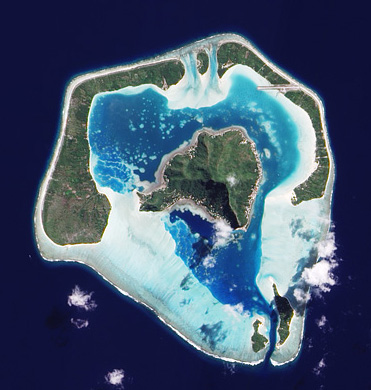
The model, part of Toomey’s dissertation research, uses existing data on reef growth to represent the relationship between coral growth, sunlight availability, and erosion. In combination with island subsidence (sinking) rates, the model calculates how a coral reef develops over hundreds of thousands of years. The model depicts a delicate balance: if the combination of sea level change and island sinking deepens the water faster than the coral can grow, the reef will drown; if the coral grows faster than the water deepens, the coral growth will catch up with the sea surface, then slow down as the reef is exposed to eroding waves at sea level.
The team can represent Darwin’s scenario by including only island subsidence, with no glacial sea level cycles. But, says Toomey, “The configuration that emerges does not resemble current reef formations.” So, they added in a sea level history based on geological evidence and paleoclimate data, which allows the model to account for a sea level oscillating between the present level and 120 meters below sea level every 100,000 years.
This time, the model, running a course of 4 glacial cycles (400,000 years) into the past, yielded a coral reef distribution that matched up well with the real world observations. The barrier reefs, drowned barrier reefs, and other forms were all in the right places. “What this suggests,” says Perron, “is that while subsidence is important, as Darwin suggested, sea level oscillations are also important for determining the distribution of reef types around the world. Daly didn’t have it entirely wrong.”
The model is sophisticated enough to explain why the Society Islands follow the Darwin progression, but others do not. According to the simulations without the sea level curve, most of the environment would be likely to make the Darwin progression. But when the sea level oscillations are included, “it turns out,” says Ashton, “there is only this little ‘Goldilocks’ zone in which you can get that progression.” Intriguingly, the parameters the model needed to create that tiny zone of Darwin progression matches up with Tahiti’s actual growth and subsidence rates. That is, Tahiti has subsided just slowly enough for the 50-meter-deep lagoon to develop over the last few glacial cycles.
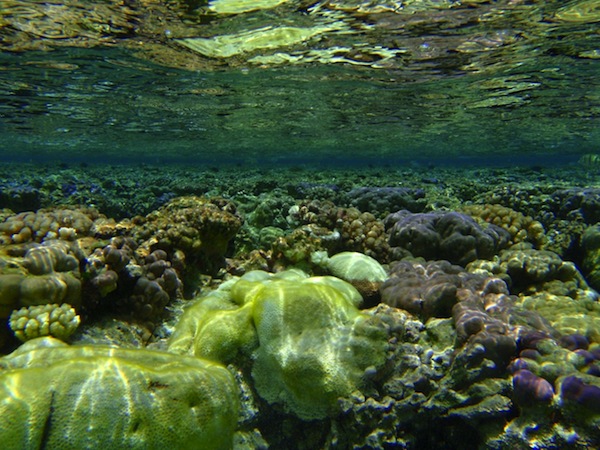
Whereas Tahiti and the other Society Islands conform to Darwin’s vision, Hawaii will never see such a configuration. It’s sinking too quickly. “The big island is screaming down faster than 2 millimeters a year,” says Perron, “and all it can do is form a little reef terrace at every sea level lowstand.” As sea level rises rapidly when the ice sheets melt at the end of each glacial period, the reef drowns and stays drowned.
It’s only the incorporation of paleoclimatological sea level data that makes the model so widely applicable. “In principle, the model can explain all the different kinds of reefs we see across the world,” Perron says.
But the model does have its limits. Remember, the model is designed to work on the order of hundreds of thousands of years. So, predicting the effects of ocean acidification and disease on coral growth in the near future isn’t in its purview. Toomey, Ashton, and Perron’s model is more of a geological time machine, allowing them to show how a coral reef responds to the wide range of conditions experienced by different islands over the last several glacial cycles. One of their future goals its to model the relationship between ancient reefs and sea level. “If sea level is such a big driving force in coral formation, what were reefs like prior to 3 million years ago, when there were no northern hemisphere glacial cycles at all?” Perron asks. “Maybe there were more barrier reefs.” Sounds like a world that Darwin would have liked.

